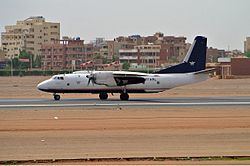Passengers 26 Aircraft type Antonov An-26-100 Date 19 August 2012 Total fatalities 32 (all) Passenger count 26 | Survivors 0 Operator Alfa Airlines Injuries (nonfatal) 0 Survivor 0 Crew count 6 | |
 | ||
Summary Crashed into a mountain while attempting to land in a dust storm Site Nuba Mountains near Talodi, South Kordofan, Sudan Similar Allied Air Flight 111, Petropavlovsk‑Kamchatsky Air Flight 251, Bhoja Air Flight 213, 2012 Indonesian Air Force, United Nations Flight 544 | ||
The 2012 Sudan Antonov An-26 crash was the 19 August 2012 crash of an aircraft near the town of Talodi, Sudan, killing all 32 persons on board. The aircraft was carrying a Sudanese government delegation. Among the victims were members of the Sudanese government, several ranking members of the Sudanese Armed Forces and other officials, and a television crew.
Contents
Aircraft
Although some early media reports mistakenly announced the crash as a helicopter crash, the aircraft involved was an Antonov An-26-100 civilian airplane, chartered for this flight by the Sudanese Government and operated by the Sudanese private air carrier Alfa Airlines (ICAO code AAJ), tail number ST-ARL.
The aircraft was built at the Ukrainian "Aviant" aircraft plant in the Soviet Union and entered service on 16 December 1974. It flew on Soviet and Russian regional routes until July 1998. It was sold to an Armenian air carrier, and then to Trans Attico, Air Libya, Ababeel Aviation, and other air companies in Africa. It was acquired by Alfa Airlines in July 2009 and was modified from Antonov An-26 to Antonov An-26-100 standard at Kiev Aircraft Repair Plant 410 in Ukraine in 2010.
There have been several deadly plane crashes in Sudan in recent years. All Sudanese airlines, including Alfa Airlines, are banned for safety reasons from flying in European airspace. The Sudanese authorities complain that it is difficult to get spare parts because of sanctions the United States has imposed against Khartoum. This crash was the first accident in the history of Alfa Airlines, which was founded only in 2009.
Passengers and crew
The chartered plane was carrying a Sudanese government delegation, from the capital of the country, Khartoum, to the town of Talodi in South Kordofan, a war-torn state with ongoing fighting between Sudan's army and rebel groups, for an Eid al-Fitr celebration, to mark the end of the holy month of Ramadan.
The official list of the passengers and crew, all of whom died in the crash, is as follows:
The aircraft was flown by a senior Russian captain, assisted by a Sudanese first officer, a 43-year-old navigator from Tajikistan and a 42-year-old Armenian flight engineer.
Crash
Antonov An-26 had taken off from Khartoum International Airport at around 6:02 a.m. local time on 19 August 2012. Approximately at 8 a.m., the plane crashed into the Hajar Al-Nar Mountain of the Nuba Mountain range near Talodi, a small town about 595 km (372 miles) southwest of Khartoum and 50 km (30 miles) from the border with South Sudan. A television statement said that the weather had prevented the aircraft from landing on its first attempt, and on its second attempt, the plane crashed into a mountain.
According to The Aviation Herald, Talodi Airstrip features a single paved, unmarked runway of 1800 m (5900 ft) length.
Investigation
An official with Sudan's Civil Aviation Authority said that bad weather was responsible for the crash. The official news agency of Sudan, SUNA, also said the crash happened "due to the bad weather conditions". Minister of Information Ahmed Bilal Osman also added that the plane was attempting to land in bad weather conditions in Talodi, as seasonal heavy rains left the pilots with "zero visibility," when it crashed into a mountain.
Rebel spokesman Arnu Ngutulu Lodi denied that his rebel forces were involved with the crash, which happened outside of rebel territory.
Two days after the crash, on 21 August 2012, Sudan Civil Aviation Authority (CAA) chief Mohammad Abdul-Aziz tendered his resignation to the President of Sudan. “As a leader of the CAA am ready to shoulder responsibility of the tragic incident regardless of its causes,” he said. However, President Bashir rejected his resignation, urging the chief to continue a newly approved program of reforms to the development and supervision of the CAA.
On 24 August 2012, the local government reported the flight recorders have been found and recovered from the crash site.
